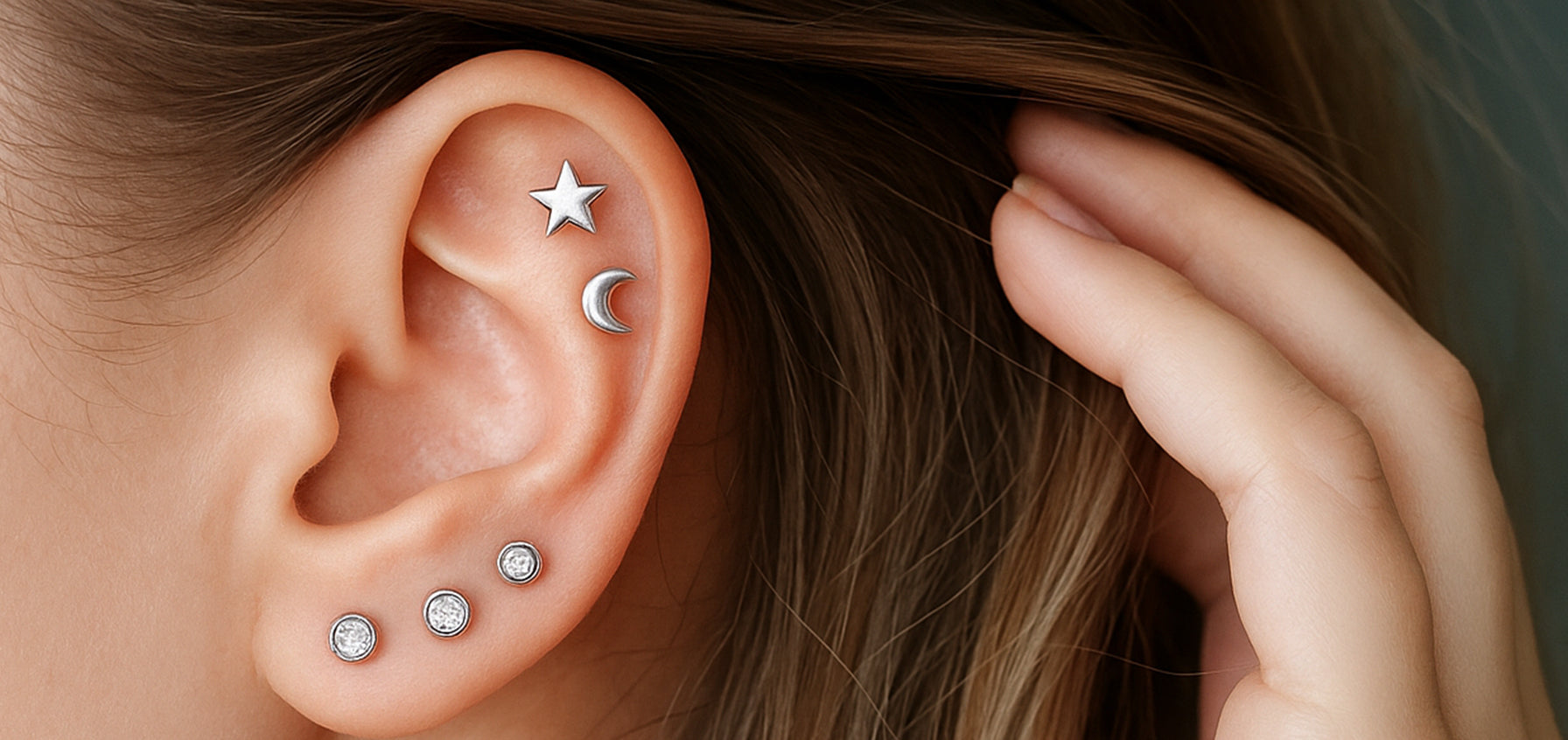
Should You Work Out with a New Piercing?
Getting a new piercing is exciting but should not be taken lightly. After all, you’ve heard your piercer go over aftercare, and you may have received a brochure listing all the things you should or should not do. But if you’re a fitness buff, play on a sports team, or have a regular cadence of working out with a personal trainer, you may wonder if working out with a new piercing is something you can reasonably do.
Whether it’s your ears, nose, navel, or nipples, each piercing requires thoughtful care during your workout routine. In this guide, we’ll cover whether you should work out with a new piercing and general tips to keep your piercings protected.
Why Working Out Can Be Risky for Fresh Piercings
When you get a new piercing, your body treats it like a wound, meaning it’s vulnerable to bacteria, friction, and impact. Working out too soon or without proper preparation can lead to:
- Infections from shared gym equipment
- Irritation caused by movement or clothing
- Prolonged healing times from repeated trauma
- Snagging or tearing from loose jewelry or fabric
The good news is that you don’t have to stop working out altogether. You just need to adjust your routine while your piercing heals.

General Tips for Working Out With Any New Piercing
Plan Ahead
If you are on a sports team or participate in organized sports, you may be required to remove your jewelry. Therefore, it’s best to wait until the off-season. Removing jewelry can cause the piercing to close quickly, especially if it isn’t fully healed. Additionally, removing and replacing jewelry can cause unnecessary trauma to a healing piercing and will only irritate it, making the healing process take longer and be more difficult. Instead, wait until you can take a break and keep the jewelry in.
If your job is a fitness instructor or something where you’re doing a lot of heavy activity, consult your piercer. They will tell you what they think before performing the piercing.
No Swimming & Surfing!
If you’re a swimmer or surfer and need to be in a pool or the ocean for your sport, consider waiting until it’s off-season before getting pierced. You cannot go into a public body of water with a healing piercing, as it can harbor bacteria that can affect your healing piercing. Additionally, you want to avoid pools because chlorine is extremely drying and can irritate the new piercing, prolonging the healing process.

Thoroughly Sanitize Equipment Before Use
Although gyms require you to wipe off the equipment before and after you sweat all over it, it’s not uncommon for people to skip this step. Think of how gross the equipment is after multiple people have used it without wiping down their sweat. Before using any equipment, including your own, thoroughly wipe it with antibacterial sanitizing wipes. Additionally, you want to avoid touching your piercing after touching any equipment, even your privately owned equipment. This is because you can introduce bacteria into the piercing. Always wash your hands after using any equipment and before touching your piercing.
Additionally, you want to avoid the piercing coming into contact with any of the equipment. This means anyone who has recently gotten their nipples pierced needs to keep their shirts on at the gym, and those with new navel piercings need to avoid crop tops or only wearing sports bras to the gym.

When you’re finished working out, shower as soon as possible. Save one of your saline rinses for directly after your workout, too. When you’re out of the shower and have washed your hands, spray the piercing with saline wound wash. Dry the piercing with a clean paper towel, gauze, or cotton swab. Do not dry the piercing with a cotton towel; it can harbor bacteria you don’t want to introduce to a healing piercing, which is essentially a healing wound.
No Sweat Towels!
While sweat itself isn’t harmful to your piercing, the bacteria that can grow because of sweat can be dangerous to your piercings. As mentioned above, you don’t want to use cotton towels to try your piercing, but you don’t want to use cotton towels to wipe sweat away, either. Instead, use a clean paper towel each time you need to wipe away your sweat and don’t reuse the same towel.
Be Careful of Friction, Pressure & Snagging
Depending on the piercing’s location, you will want to avoid specific workouts that could cause the piercing to move, place pressure on the piercing, or cause the piercing to get snagged on any equipment. If you have a new ear or eyebrow piercing, you must be careful of any helmets or headgear you wear. Jewelry can easily get caught and snagged. Plus, the movement of putting on or taking off any headgear or a helmet can irritate the piercing and prolong the healing process. It’s best to avoid workouts and sports where you have to do this until after the piercing has fully healed.

If you have a new navel or nipple piercing, avoid exercises like push-ups, bench presses, sit-ups, crunches, or burpees (where you slam down on the ground) to keep the area safe from any unnecessary movement and pressure. If you’re a dancer or participate in yoga, where you do a lot of repetitive bending, it may be best to do other workouts to avoid unnecessary pressure on the piercing. It’s also best to listen to your body. If the area with the piercing is tender after any type of workout, it’s best to switch to something else to meet your fitness goals and slowly work the activity back in once it no longer hurts to do said activity.
Consult your piercer about certain exercises you’re curious about and the specific piercing you’ll be healing.
Always Wear Clean Outfits
As mentioned above, sweat isn’t harmful to your healing piercing. However, it is not advised to leave a sweaty shirt in your gym bag and throw it on the following day without washing it. Bacteria and other microorganisms can collect and make their way into your fresh piercing, which is a healing wound. Therefore, you always want to wear clean clothing to work out in, even if you’re just going to sweat in them at the gym and make them dirty. This is especially true if your piercings come into direct contact with your clothing.
Speaking of clothing, you should avoid tight, restrictive clothing while the new piercing heals. This is especially the case for navel, sternum, or nipple piercings. For navel piercings, avoid high-waisted workout pants or waistbands that will dig into the area. Instead, opt for loose, breathable clothing made of moisture-wicking material, like bamboo, cotton, or athletic-grade polyester.

To help protect a new navel piercing, the Association of Professional Piercers (APP), recommends getting a hard, vented eye patch and securing it around your belly button with an elastic bandage (like an ACE bandage) or stockings.
For those with new nipple piercings who wear bras, a supportive but not compressive sports bra should be worn. To avoid snagging your nipple jewelry, wear bras that are cotton-lined and don’t have stiff underwires or mesh lining. You can also put folded gauze or paper towels inside the bra to prevent friction from the clothing against the jewelry, which can cause the jewelry to move or jostle during intense movements like running, cycling, or other upper body workouts.
Key Takeaways
You don’t need to give up your workout routine for a new piercing. You just need to be smart and consider alternatives if there’s a particular movement you need to avoid during the healing process. Always listen to your body and avoid any movement if it hurts. Consult your piercer for specific questions about working out and aftercare with your new piercing.

